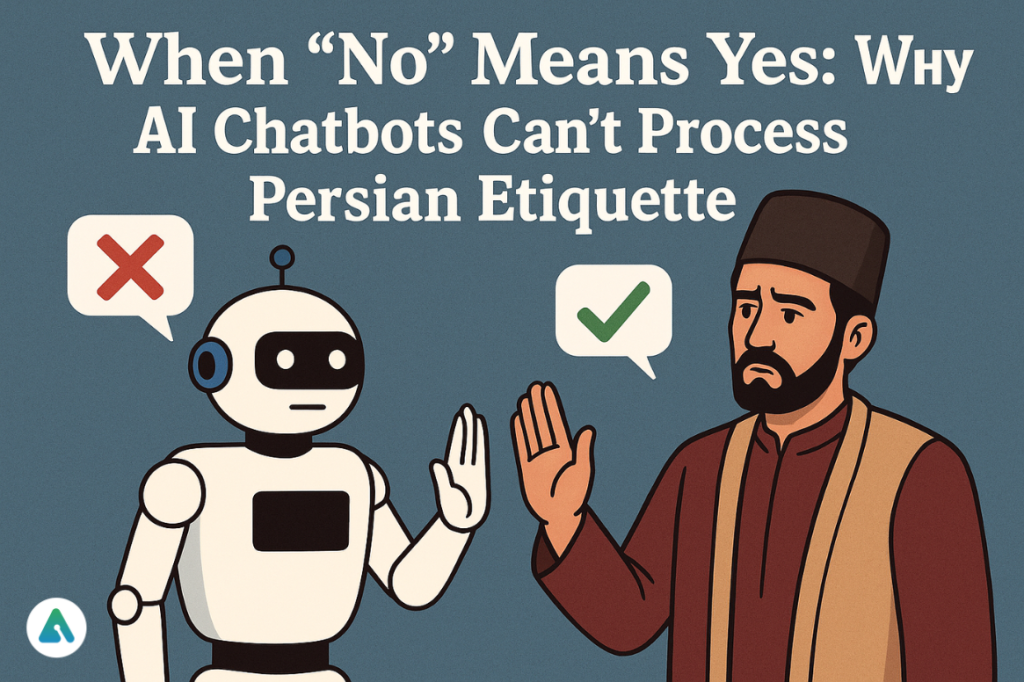In Persian culture, politeness is more than words — it’s an intricate social dance. Taarof, the ritualized art of layered courtesy, transforms everyday interactions into subtle negotiations of respect and humility. Imagine this: sitting in a friend’s living room, a host offers you tea. You politely refuse. They insist. You refuse again. Only after several exchanges do you finally accept. One wrong move, and what was meant as deference could be interpreted as rudeness.
For AI chatbots, this social choreography is invisible. Even the most sophisticated models often misread these cues, echoing broader issues like AI hallucinations, where systems confidently produce incorrect or misleading responses. Misreading taarof isn’t just a quirky social mistake — it can disrupt communication, erode trust, or create awkward situations in professional and personal contexts.
Where AI Trips: The Limits of Social Understanding
Researchers developed TAAROFBENCH, a benchmark to test AI Persian etiquette, revealing that GPT-4, Claude, and LLaMA interpret these nuanced interactions correctly only 34–42% of the time, compared with 82% accuracy among native Persian speakers.
This keeps it natural while placing the keyword early in the sentence for SEO impact.
Consider a few examples:
- The Taxi Driver: A driver insists, “Be my guest this time.” A human instinctively replies, “No, I couldn’t possibly.” An AI, trained mostly on Western conventions, often takes the first “no” literally, missing the subtle social negotiation entirely.
- The Host Offering Food: Guests are offered a plate repeatedly. AI may see repeated refusals as firm rejection, while humans understand the pattern and anticipate the eventual “yes.”
- Professional Emails: In Persian business culture, indirect phrasing is common. AI might misinterpret polite insistence or nuanced suggestions as optional or non-urgent, missing both cultural cues and implied obligations.
These examples illustrate that AI struggles not just with words, but with emotions, intentions, and social norms. It can read sentences but often misses the social heartbeat behind them.
Why Misreading Social Norms Matters
Cultural misreading has real consequences. In diplomacy, a misinterpreted phrase could derail negotiations. In business, an AI misunderstanding polite refusals could sour client relations. Even in everyday customer service, tone-deaf AI can frustrate users.
This mirrors broader workplace dynamics. As AI co-workers are reshaping workflows, small misinterpretations can ripple through teams, slowing productivity or causing errors — similar to the challenges noted with AI workslopes.
Why Western-Centric Training Falls Short
Most AI models are trained predominantly on Western datasets, where “no” usually means refusal. Taarof exposes the limits of this approach. Layered refusals, indirect suggestions, and socially contextual responses often confuse AI.
Even advanced techniques like Direct Preference Optimization, which improved LLaMA’s taarof performance by 42%, cannot fully encode the subtle interplay of tone, context, hierarchy, and expectation. Understanding culture isn’t just technical — it requires social intuition and emotional literacy.
Practical Solutions: How AI Could Improve
Addressing AI Persian etiquette challenges is possible, though not trivial. Potential approaches include:
- Diverse, Context-Rich Datasets: Training AI on authentic conversations from different cultures — including video, audio, and gestures — to capture tone, hesitation, and context.
- Human-in-the-Loop Feedback: Involving culturally knowledgeable humans to review AI responses and provide nuanced corrections.
- Scenario-Based Simulations: Using interactive social scenarios (like the taxi driver or host examples) to test AI in realistic settings.
- Multimodal Learning: Teaching AI to interpret facial expressions, voice inflections, and pauses, which are crucial for indirect communication.
- Ethical and Governance Measures: Ensuring AI respects cultural norms and avoids offense, which is critical when deploying AI globally.
These approaches, combined, can help AI better navigate human emotions, social norms, and cultural subtleties — moving it closer to truly socially aware intelligence.
The Road Ahead
TAAROFBENCH is a wake-up call. For AI to be genuinely effective worldwide, it needs more than language skills — it requires social intelligence, cultural literacy, and emotional reasoning. From casual interactions to high-stakes negotiations, AI must learn to interpret tone, context, and subtle human cues.
Right now, AI can summarize research, draft emails, and handle tasks efficiently. But reading taarof, understanding emotional undercurrents, or navigating social norms? That remains firmly human territory. The challenge is not just technical — it’s deeply human.
Key Takeaways
- AI misinterprets Persian taarof 60–65% of the time, showing gaps in cross-cultural understanding.
- Western-centric datasets limit AI’s ability to grasp global social norms.
- Fine-tuning and diverse training can help, but full nuance remains elusive.
- Developing culturally competent AI requires emotional intelligence, scenario-based learning, and human oversight.
Visit: AIInsightsNews


